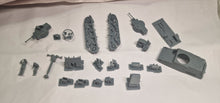
Il carro leggero 7TP, prodotto dalla PZI, fu l'unico carro armato prodotto in Polonia prima dello scoppio della Seconda guerra mondiale. Il veicolo deriva strettamente dal Vickers Six-ton, che era stato acquistato in 50 esemplari nel 1931. Il modello era stato apprezzato dai vertici dell'esercito, ma ne erano state anche evidenziate alcune pecche, fra cui l'insufficiente potenza del motore. Acquisita la licenza per produrre il Six-ton, i tecnici della PZI si misero al lavoro per modificare il progetto, disegnando una torretta ex novo e modificando la parte posteriore della sovrastruttura per ospitare il nuovo propulsore svedese Saurer a 6 cilindri, costruito anch'esso su licenza in Polonia. I primi prototipi vennero completati nel 1935, dopo di che ne venne avviata la produzione in serie. Inizialmente il mezzo prevedeva un armamento limitato a due mitragliatrici poste in due torrette, ma presto tale soluzione venne accantonata in favore di quella mono-torretta con un cannone Bofors da 37 mm accoppiato da una mitragliatrice Browning da 7,92. Tale versione, che fu poi quella largamente più utilizzata, entrò in produzione nel 1937. Le limitazioni di budget per le forze armate fecero sì che alla data del 1° settembre 1939, quando i tedeschi attraversarono il confine, solo 136 7TP erano stati distribuiti ai reparti combattenti, perdipiù sparpagliati in tante piccole formazioni. Presi singolarmente, i tanks polacchi erano molto superiori ai Panzer I e II che formavano il grosso delle divisioni della Wehrmacht, ma il loro numero limitato, la debole corazzatura che li esponeva al fuoco micidiale degli anti-carro nemici da 37 mm e l'errata disposizione del comando polacco fecero sì che il contributo offerto dai 7TP alla resistenza di fronte all'invasione tedesca si rivelasse piuttosto limitato.
In ogni confezione Mussini è presente un 7TP in scala 1/72. Il kit in resina, stampato in 3D con una risoluzione 12k, comprende due figurini, il comandante e il pilota del carro, e consente la possibilità di montare gli sportelli sia del conducente che del vano motore aperti o chiusi. Così come di montare le scatole sui parafanghi aperte o chiuse. Sono incluse due torrette, una con lo sportello aperto e l'altra con lo stesso chiuso. Anche l'interno della camera di combattimento è riprodotto fedelmente, incluso il motore.
Prodotto non adatto a minori di 14 anni. Pitture, colle e altri materiali non sono inclusi nella confezione. Alcune parti potrebbero essere piccole o con sporgenze affilate.
Note
L'articolo viene venduto da montare e NON dipinto.
The 7TP light tank, produced by PZI, was the only tank produced in Poland before the outbreak of the Second World War. The vehicle derives strictly from the Vickers Six-ton, which had been purchased in 50 units in 1931. The model had been appreciated by the leaders of the polish army, but some flaws were also highlighted, including insufficient engine power. Having acquired the license to produce the Six-ton, the PZI technicians worked to modify the project, designing a turret from scratch and modifying the rear part of the superstructure to house the new Swedish 6-cylinder Saurer engine, also built licensed in Poland. The first prototypes were completed in 1935, after which series production began. Initially the vehicle had a limited armament of two machine guns placed in two turrets, but soon this solution was set aside in favour of the single-turret one with a 37 mm Bofors cannon coupled with a 7.92 Browning machine gun. This version, which was later the most widely used, went into production in 1937. Budget limitations for the army meant that by 1 September 1939, when the Germans crossed the border, only 136 7TPs had been distributed to the combat units. Worst, they were also scattered in many small formations. Taken individually, the Polish tanks were far superior to the Panzer I and II that made up the bulk of the Wehrmacht divisions, but their limited number, the weak armour that exposed them to the deadly fire of the enemy 37mm anti-tank and the wrong disposition of the Polish command meant that the contribution offered by the 7TPs to the resistance in the face of the German invasion turned out to be rather limited.
In each Mussini package, there is a 7TP model in 1/72 scale. The resin kit, 3D printed with a 12k resolution, includes two figures, the tank commander and the driver, and offers the possibility to assemble the driver and engine compartment hatches either open or closed. Additionally, the fender boxes can be mounted open or closed. Two turrets are included, one with the hatch open and the other closed. The interior of the combat chamber is also faithfully reproduced, including the engine.
Disclaimer
Product not suitable for children under 14 years. Paints, glues, and other materials are not included in the package. Some parts may be small or have sharp edges.
Notes
The item is sold unassembled and NOT painted.

































